文章信息
- 姜鑫贵, 周金星, 刘玉国, 董林水, 崔明
- Jiang Xingui, Zhou Jinxing, Liu Yuguo, Dong Linshui, Cui Ming
- 青藏铁路南山口段沙害防治措施的效果
- Effectiveness of Sand Control Measures in Nanshankou Area along Qinghai-Tibet Railway
- 林业科学, 2016, 52(10): 55-63
- Scientia Silvae Sinicae, 2016, 52(10): 55-63.
- DOI: 10.11707/j.1001-7488.20161007
-
文章历史
- 收稿日期:2016-06-27
- 修回日期:2016-08-11
-
作者相关文章
2. 北京林业大学水土保持学院 北京 100083;
3. 滨州学院 山东省黄河三角洲生态环境重点实验室 滨州 256603
2. School of Soil and Water Conservation, Beijing Forestry University Beijing 100083 ;
3. Key Laboratory of Eco-Environmental Science for Yellow River Delta of Shandong Province Binzhou University Binzhou 256603
青藏铁路是世界上海拔最高的铁路,由于地处青藏高原的独特地理区位和脆弱生态环境使其运营安全倍受关注。青藏铁路全线累计有各种沙害路段440 km,占线路总长的22.5%,风沙灾害问题严重(李顺平等,2014;张克存等,2014)。当前,利用工程措施、生物措施、化学措施并通过固沙、阻沙、疏沙的方式防治风沙区的铁路沙害,取得了很好成效(Zhang et al., 2007;唐玉龙,2013)。然而,青藏铁路沿线存在着植物生长缓慢、优良植物材料匮乏的技术瓶颈(杨洪晓等, 2004;Li et al., 2006;Zhou et al., 2014),独特的高海拔低气压环境下的风沙运动规律与低海拔地区也不尽相同(谢胜波等,2014),其他沙区铁路的防治经验无法直接应用,给铁路防沙工作带来了很大挑战。青藏铁路沿线采用最多的是机械防沙措施(牛清河等,2009),相关部门在铁路沿线布置了不同类型的机械沙障,初步保障了铁路的安全运营。已有学者对红梁河、错那湖和沱沱河铁路段沙害区的机械固沙措施的结构配置、固沙机理进行了详细研究(张克存等,2010;Zhang et al., 2012),为青藏铁路沿线中度、重度沙害区的机械沙障的科学合理布设提供了指导。青藏铁路轻度沙害段占青藏铁路沙害段总长的64.09%(谢胜波等,2014),目前也多采用与中度、重度沙害区相同的工程防沙治沙措施,而这样会导致工程量大、投资高等问题,这样的防沙措施配置是否合理和效果如何以及如何有效防治轻度沙害区沙害,都还值得探讨研究。本文在南山口调查和计算了不同工程阻沙措施的阻沙量,来评估机械沙障的阻沙效益,同时分析沙障空间布局对防沙效益的影响,旨在为高原铁路沙害的防治及防沙措施的合理布设提供建议和参考。
1 研究区概况南山口位于柴达木盆地南缘、格尔木市南30 km处,为新青藏铁路的起点(图 1),属高原大陆性气候,多风、干旱,年均降水量仅42.2 mm。土壤以灰棕漠土为主,植被稀少,为典型荒漠区。该地常年盛行西北风、西南风,年均风速2.2 m·s-1,春季风速最大而秋季最小。由于植被稀少,地表松散物质较多,沙尘天气发生频率高,发生时间较为集中,3-6月份是高发期,其中4,5月份达到峰值,期间的沙尘暴强度也最大。该段虽然气候干燥少雨,但所属格尔木市水资源比较丰富,地表水资源主要来自于格尔木河,水资源的开发利用主要通过渠道直接从格尔木河引水用于林地灌溉及城市环境用水(李颖智等,2011)。格尔木市境内天然林很少,主要为胡杨(Populus euphratica)林和天然灌木林,人工林树种主要以青杨(P. cathayana)、新疆杨(P. albavar. pyramidalis)等杨树为主,其次有垂柳(Salix babylonica)、沙枣(Elaeagnus angustifolia)、榆树(Ulmus pumila)、紫穗槐(Amorpha fruticosa)等。
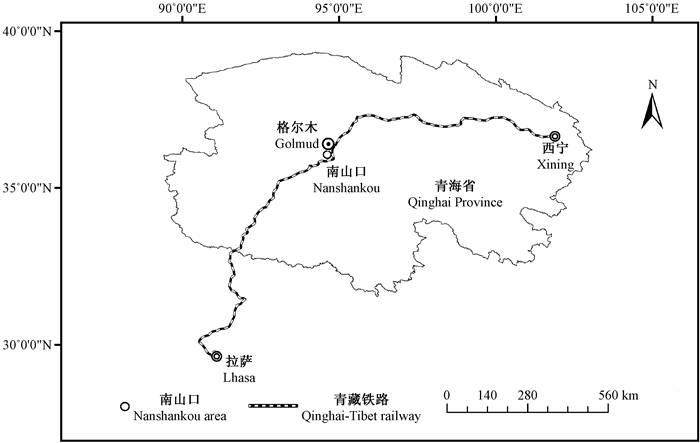
|
图 1 南山口地理位置 Fig.1 Nanshankou's location |
青藏铁路南山口段部分区段于2009年9月布设了高立式和低立式2类沙障,通过拦截上风向风沙流中的沙粒,使其沉积在沙障附近,从而防护铁路的安全运营(李凯崇等,2015)。沙障主要布设在铁路线的迎风侧--西侧,走向与铁路走向一致(NE-SW)。高立式沙障为PE(聚乙烯,polyethylene)阻沙网和废弃轮枕构成的栅栏沙障(图 2a,b),高度分别为160,210 cm。低立式沙障为PE网格沙障(图 2c),网格均为1 m×1 m,高度为20 cm。具体措施布设如图 3所示。每道沙障近铁路侧记为L,远铁路侧记为R。
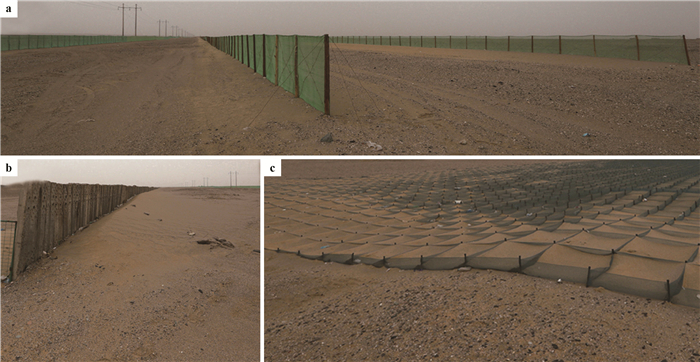
|
图 2 南山口阻沙措施 Fig.2 Sand control measures in Nanshankou a:PE阻沙网;b:栅栏沙障;c:PE网格沙障。 a: Sand blocking PE nets(SBPNs); b: Sand fences(SFs); c: PE checkerboard barriers(PCBs). |
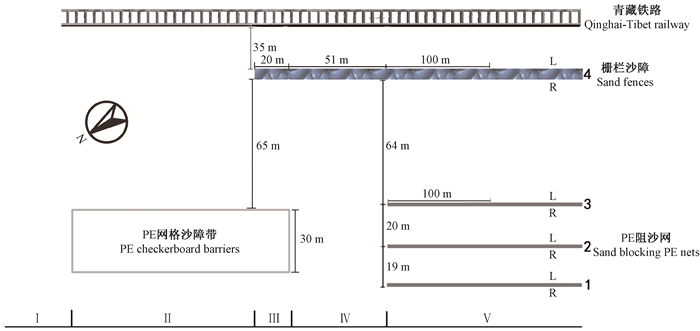
|
图 3 不同防护措施组合分区 Fig.3 The sketch map of the 5 zones with different sand control measures L代表沙障近铁路一侧,R代表沙障远铁路一侧。 L represents the side of sand barrier near railway, and R represents the side of sand barrier away from railway. |
根据青藏铁路南山口段不同区段沙障的组合方式,设置无防护措施的对照区和4个不同措施防护区:Ⅰ区为无防护措施区;Ⅱ区为低立式PE网格沙障防护区,全长为1 km;Ⅲ区为高立式栅栏沙障与低立式PE网格沙障共同防护区,全长为20 m;Ⅳ区为高立式栅栏沙障防护区,全长为70 m;Ⅴ区为高立式栅栏沙障与高立式PE阻沙网防护区,全长为5.8 km。2015年8月末,选取Ⅱ区的4列PE网格沙障,Ⅲ区、Ⅳ区的全部,以及Ⅴ区沙障的前100 m作为测定范围(图 3),对铁路沙障阻沙效果进行评估。采用测定积沙体断面要素计算栅栏沙障和PE阻沙网的阻沙量,采用测定平均深度的方法计算PE网格沙障内的阻沙量,从而测算出不同区段的6年间的阻沙量,并以不同防护措施组合的年均单宽阻沙量为主要指标评估不同沙障组合的阻沙效果。
2.1 栅栏沙障与PE阻沙网积沙量采集与计算栅栏沙障和PE阻沙网积沙量的测定借鉴牛清河等(2009)采用的断面测量方法,并加以改进,即将沙障拦截的沙物质形成的积沙体分成若干个小的积沙体,根据积沙多少将小积沙体断面分成3种类型,并分类测定断面要素。类型一:有明显积沙并出现沙脊的断面(图 4a),测定要素为沙障露出地面高度H,沙障露出积沙体高度h,沙脊距沙障最高点的垂直距离h′,沙脊距沙障的水平距离L1,距积沙体边缘的水平距离L2;类型二:有明显积沙但没有沙脊的断面(图 4b),测定要素为沙障露出地面高度H,沙障露出积沙体高度h,积沙体的水平长度L;类型三:有少量积沙的断面(图 4c),测定要素为积沙体的水平长度L,均匀分布的5个点上的积沙深度h1,h2…h5。根据测得的要素将类型一的面积等效为梯形与三角形面积之和,类型二的面积等效为三角形的面积,类型三的面积等效为长方形的面积。
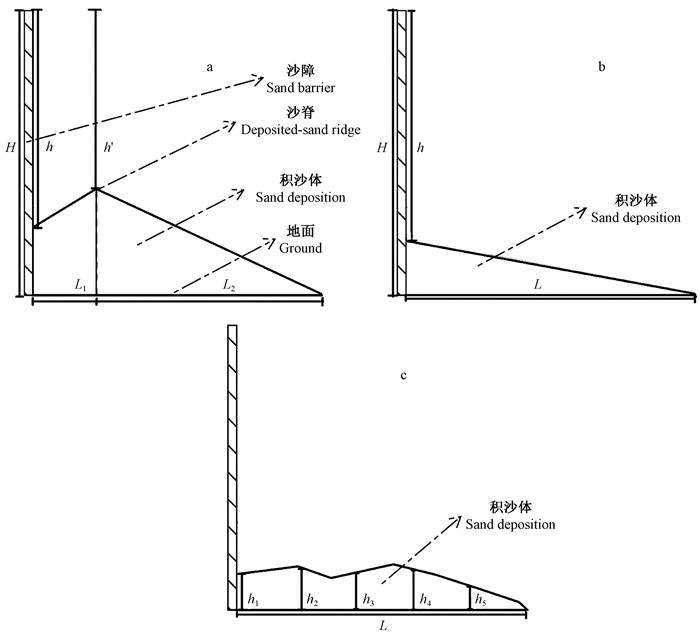
|
图 4 积沙体横断面调查要素 Fig.4 Survey elements of the cross section profile of sand deposition |
因小积沙体i2个截面之间距离Li较小,2个截面面积Ai1和Ai2之间的断面面积在距离Li上是线性变化,由此可根据如下公式求得小积沙体的体积Vi;对所需区段内的小积沙体的体积求和可得到区段内的积沙体体积,除以所需区段的总长度即得区段的单宽积沙量。
| ${V_i} = \int_0^{{L_i}} {\left({{A_{i1}} - \frac{{{A_{i1}} - {A_{i2}}}}{{{L_i}}} \times x} \right)} {\rm{d}}x.$ |
式中:i为小积沙体编号;i1, i2为小积沙体i的2个侧面;Li为小积沙体i的长度;x为小积沙体内某处断面距截面i1的垂直距离。
2.2 PE网格沙障积沙量采集与计算PE网格沙障的布设位置靠近铁路,原始地表为比较平整的戈壁,将PE网格沙障内的沙物质等效为长方体进行处理,以沙障的底面积作为长方体的底面积,在PE网格沙障内选9个点(图 5),取其深度的平均值作为长方体的高,以算出的长方体体积作为沙障的积沙量。根据该段的盛行风向,抽取4列垂直于铁路走向的PE网格沙障共120个网格,测定积沙量。
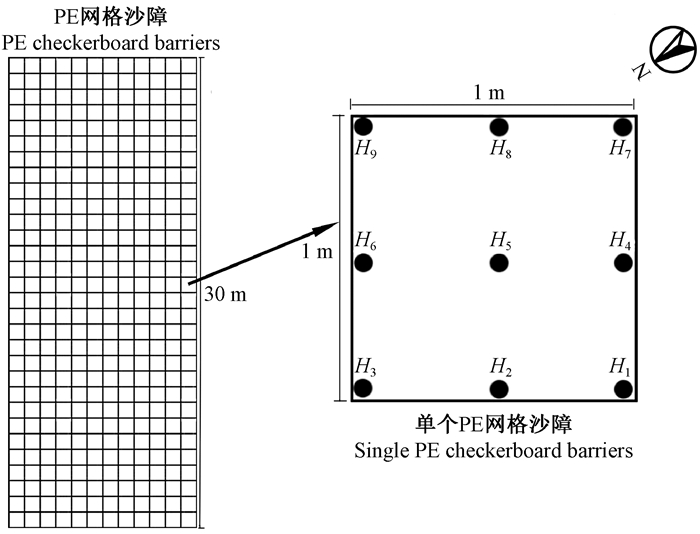
|
图 5 PE网格沙障积沙量调查示意 Fig.5 Survey diagram of deposited-sand volume in PE checkerboard barriers H1, H2,…H9:深度测量点的位置 The position of the depth measurement. |
南山口段不同沙障组合防护区段的阻沙情况见表 1。4个不同措施组合防护区中,Ⅲ区沙障内年均单宽阻沙量最大,为1.125 m3·m-1,可见,高立式沙障与低立式沙障组合能够发挥最佳的阻沙作用。其次为Ⅳ区,年均单宽阻沙量可达0.978 m3·m-1,约为Ⅲ区的87%,可见,单一的高立式栅栏沙障也能发挥较好阻沙效果。Ⅴ区沙障内年均单宽阻沙量为0.887 m3·m-1,仅为Ⅲ区的79%,甚至小于Ⅳ区,说明高立式PE阻沙网的布设不仅没增强拦沙量,反而降低了同区内高立式栅栏沙障的阻沙效益。对比Ⅱ区与Ⅳ区、Ⅴ区的年均单宽阻沙量,可以看出,总体上高立式沙障的阻沙效果好于低立式。而对照的无措施区内没有积沙,对应铁路轨道也没有积沙现象,可见,南山口地区的沙害程度较轻。
|
|
分别测算了沙障迎风侧和背风侧即沙障(R,L)两侧的积沙量,得出了每个沙障两侧的平均单宽积沙量及总积沙量(表 2)。由表 2可以看出,Ⅴ区中3道PE阻沙网与栅栏沙障的阻沙量分别为该区总阻沙量的26.58%和73.42%。栅栏沙障位于3道PE阻沙网的下风向64 m处,风沙流在经过PE阻沙网的拦截后,被栅栏沙障再次拦截,在此过程中,风中携沙量逐渐减少,但栅栏沙障的阻沙量却是3道PE阻沙网总阻沙量的近3倍,说明此处的栅栏沙障的阻沙能力远远强于PE阻沙网。
|
|
1~3号沙障为3道PE阻沙网,其阻沙量沿风向呈现出快速递减的趋势。第1道沙障的阻沙量最大,6年单宽阻沙量为1.279 m3·m-1,年均单宽阻沙量0.213 m3·m-1,小于年均单宽阻沙量0.35 m3·m-1的低立式PE网格沙障。第2道沙障阻沙量仅为第1道沙障的10%,而第3道沙障阻沙量不到第1道的2%,但位于3道沙障之后的栅栏沙障却拦截了大量的沙物质,说明即使在风沙流沙量充足的情况下,第2、3道沙障的阻沙作用微乎其微。其主要原因可能在于3道沙障的间距过小,PE阻沙网高160 cm,而间距均为20 m左右,风沙流在经过第1道沙障的拦截后风场发生变化,风沙流被抬升(赵国平等,2006;何志辉等,2014;景文宏等,2016),致使第2、3道沙障没有充分发挥阻沙作用。
从沙障的单侧积沙量来看,第1道PE阻沙网的积沙75%以上分布于背风侧,而栅栏沙障72%分布于迎风侧,可见,2种沙障虽然都是高立式沙障,但是阻沙机制不尽相同。
3.3 PE网格沙障积沙效果分析根据该段的盛行风向,抽取4列垂直于铁路走向的PE网格沙障共120个网格测定积沙量,得出平均每个方格沙障积沙量为0.07 m3;采用一列方格沙障(宽度为1 m,长度为30 m)的总阻沙量代表方格沙障的单宽积沙量,得出方格沙障的单宽积沙量为2.1 m3·m-1。此外,计算每一行上的平均值,来观察PE网格沙障沿风向的积沙量变化(图 6)。由图 6可看出,单个网格的积沙量沿风向逐渐降低。主要是因为风吹向铁道的过程中,由于方格沙障的逐步拦截,风沙含量会沿下风方向相应减小(高永等,2004;屈建军等,2005;周娜等,2014)。而网格的累积积沙量呈现出对数上升的趋势,13行之后上升的趋势慢慢变缓,随着PE网格沙障数量的增加,阻沙量增加缓慢直至几乎不再增加,而布设的沙障所需的材料量是呈直线上升的,由此可以看出,PE网格沙障存在一个合适的带宽,能实现阻沙效果与经济成本最优化。通过本研究的计算,认为南山口区的PE网格沙障的最优宽度为13 m。
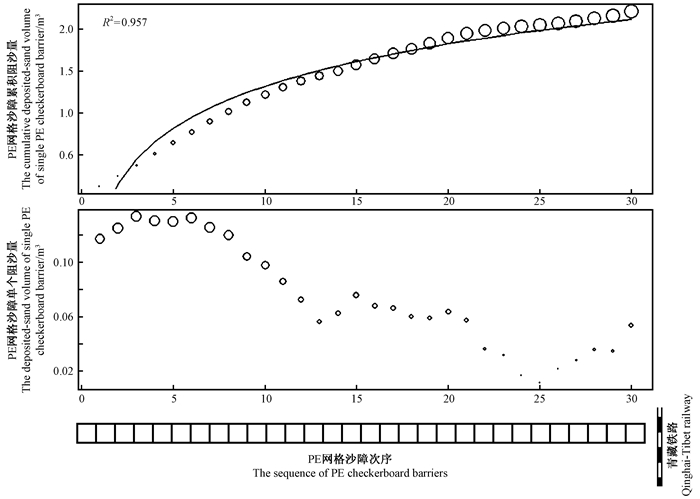
|
图 6 PE网格沙障积沙量 Fig.6 Deposited-sand volume of PE checkerboard barriers |
风沙对铁路的影响主要体现在沙物质堆积在铁路上对铁路运输造成威胁和风沙流对铁路道轨的磨损作用。本文研究表明,青藏铁路南山口段年均单宽风沙流量至少为1.125 m3·m-1a-1,6年累积的最大单宽积沙量为6.75 m3,与措那湖段单个阻沙栅栏最大积沙量150.9 m3·m-1 (谢胜波等,2014)相比,风沙量不是很大;无防护措施的对照区内没有积沙,对应的铁路道床和路基都没有积沙现象,不存在沙物质堆积在铁路上的威胁,同时目前也没有观察到轨道出现明显磨损,说明南山口的沙害较轻。
在当前的单个防沙措施中,栅栏沙障的单宽阻沙量最大;从不同组合措施的阻沙量来看,PE网格沙障与栅栏沙障组合的阻沙量最大。根据对不同类型沙障的材料费用(表 3)计算可以得出,PE网格沙障与栅栏沙障组合的阻沙量比单个栅栏沙障的阻沙量增加了15%,但成本相应增加了76%,而2种方式防护下的铁路路面与路基都没有积沙现象。可见,单个栅栏沙障用于南山口的阻沙,既可达到阻沙目的,又可节约成本。从表 3还可看出,PE阻沙网成本非常低,今后可考虑通过工艺调整阻沙网疏密度来增强其阻沙作用。
|
|
此外,南山口现有的防沙措施全部为机械沙障,还未考虑植物措施。实践证明,植物可通过茎叶有效阻挡气流运动,改变近地表风速廓线,减少近地表气流的风动量(韩致文等,2004)。沙生植物发达的根系还能固结周围沙层,且植物成活后将是一种永久防沙措施,对抑制土壤沙化、减弱沙害能起到长期效果(何介南等,2016)。因此,在具备植物生长和恢复条件的沙害路段,应采取植物固沙措施(高越等,2015)。南山口虽然气候干燥,降水很少,但南山口与格尔木市区临近,可依托市区灌溉设施提供水源。另外,采用植物措施固沙工程量小、投资少且效果突出,建议今后南山口铁路段的沙害防治应更多将工程措施与植物措施结合,逐步采用植物措施代替机械沙障,既可起到阻沙效果,从根本上防治沙害,同时起到改良土壤和改善铁路两侧景观的作用(于洋等,2013;邢存旺等,2014)。
5 结论青藏铁路南山口段的现有阻沙措施年均单宽阻沙量最大为1.125 m3·m-1a-1,对照区无防护措施段对应的铁路轨道没有积沙现象,目前也没有观察到明显磨损。可见,南山口地区的沙害程度较轻,在此处布设沙障不合理,积沙较多的沙障甚至还可能发展成为沙源地,将沙引向铁路路基。
比较不同防护措施组合的年均单宽阻沙量可看出,Ⅲ区高立式栅栏沙障与低立式PE网格沙障共同防护区的阻沙效果最好,低立式PE网格沙障在一定程度上缓解了高立式栅栏沙障的拦沙压力,从而可延长高立式治沙措施的使用年限;但是综合考虑经济成本,高立式栅栏沙障单项措施即可在南山口段铁路防沙中发挥重要作用。此外,建议采用植物措施代替低立式PE网格沙障,既可起到阻沙作用,也可改善铁路两侧景观。
PE阻沙网的成本较低,有望在今后防沙治沙工作中发挥重要作用,但本研究中Ⅴ区的3道高立式PE阻沙网由于布设距离过近,不能充分发挥拦沙作用,而且降低了同区内高立式栅栏沙障的拦沙效益;研究认为防护区内PE网格沙障布设宽度应以13 m为宜,宽度过大会造成材料的浪费。本研究结果可为铁路轻度沙害地段科学、合理的布设防护措施提供依据。
| [] |
高永, 邱国玉, 丁国栋, 等. 2004. 沙柳沙障的防风固沙效益研究. 中国沙漠 , 24 (3) : 365–370.
( Gao Y, Qiu G Y, Ding G D, et al.2004. Effect of Salix psammophila checkerboard on reducing wind and stabilizing sand. Journal of Desert Research , 24 (3) : 365–370. [in Chinese] ) |
| [] |
高越, 陈慧娥, 张中琼, 等. 2015. 风沙地区铁路深路堑防护形式分析. 铁道建筑 (6) : 101–104.
( Gao Y, Chen H E, Zhang Z Q, et al.2015. Analysis of protective types of railway deep cut in wind drift sand region. Railway Engineering (6) : 101–104. [in Chinese] ) |
| [] |
韩致文, 王涛, 董治宝, 等. 2004. 风沙危害防治的主要工程措施及其机理. 地理科学进展 , 23 (1) : 13–21.
( Han Z W, Wang T, Dong Z B, et al.2004. Main engineering measurements and mechanism of blown sand hazard control. Progress in Geography , 23 (1) : 13–21. [in Chinese] ) |
| [] |
何介南, 徐杰, 康文星, 等. 2016. 若尔盖县土地沙化程度演变动态特征. 林业科学 , 52 (1) : 159–165.
( He J N, Xu J, Kang W X, et al.2016. Evolution dynamic characteristics of land desertification in Zoige county, China. Scientia Silvae Sinicae , 52 (1) : 159–165. [in Chinese] ) |
| [] |
何志辉, 李生宇, 王海峰, 等. 2014. 塔克拉玛干沙漠4种结构尼龙阻沙网的防风阻沙效益对比. 干旱区研究 , 31 (2) : 369–374.
( He Z H, Li S Y, Wang H F, et al.2014. Comparison of wind prevention and sand blocking effects of 4 types of sand blocking nylon nets in the central Taklimakan desert. Arid Zone Research , 31 (2) : 369–374. [in Chinese] ) |
| [] |
景文宏, 程建军, 蒋富强. 2016. 轨枕式挡墙挡风沙功效的数值模拟及试验研究. 铁道科学与工程学报 , 13 (1) : 46–54.
( Jing W H, Cheng J J, Jiang F Q.2016. Numerical simulation and experimental research on effect of sleeper typed retaining wall for wind and sand retaining. Journal of Railway Science and Engineering , 13 (1) : 46–54. [in Chinese] ) |
| [] |
李凯崇, 薛春晓, 刘贺业, 等. 2015. 不同类型挡沙墙风沙防护机理的风洞实验研究. 铁道工程学报 , 32 (1) : 17–21.
( Li K C, Xue C X, Liu H Y, et al.2015. Wind tunnel test on sand-preventing mechanism of different kinds of sand-barriers. Journal of Railway Engineering Society , 32 (1) : 17–21. [in Chinese] ) |
| [] |
李顺平, 蒋富强, 薛春晓, 等. 2014. 青藏铁路格拉段沙害现场调查及防治研究. 铁道工程学报 (5) : 1–5.
( Li S P, Jiang F Q, Xue C X, et al.2014. Field investigation of sand disaster and prevention research on the Golmud-Lhasa section of Qinghai-Tibet railway. Journal of Railway Engineering Society (5) : 1–5. [in Chinese] ) |
| [] |
李颖智, 佟元清, 张森琦, 等. 2011. 格尔木市水资源优化配置研究. 中国农村水利水电 (2) : 46–49.
( Li Y Z, Tong Y Q, Zhang S Q, et al.2011. Optimal allocation of water resources in Golmud city. China Rural Water & Hydropower (2) : 46–49. [in Chinese] ) |
| [] |
牛清河, 屈建军, 张克存, 等. 2009. 青藏铁路典型路段风沙灾害现状与机械防沙效益估算. 中国沙漠 , 29 (4) : 596–603.
( Niu Q H, Qu J J, Zhang K C, et al.2009. Status of aeolian-sand disaster and estimation of mechanical sand-controlling benefit at typical sections of Qinghai-Tibet railway. Journal of Desert Research , 29 (4) : 596–603. [in Chinese] ) |
| [] |
屈建军, 凌裕泉, 俎瑞平, 等. 2005. 半隐蔽格状沙障的综合防护效益观测研究. 中国沙漠 , 25 (3) : 329–335.
( Qu J J, Ling Y Q, Zu R P, et al.2005. Study on comprehensive sand-protecting efficiency of semi-buried checkerboard sand-barriers. Journal of Desert Research , 25 (3) : 329–335. [in Chinese] ) |
| [] |
唐玉龙. 2013. 青藏铁路西格段戈壁风沙流防治体系研究. 中国沙漠 , 33 (1) : 72–76.
( Tang Y L.2013. Wind-blown sand prevention system at Gobi desert area along Xining-Golmud section of Qinghai-Tibet railway. Journal of Desert Research , 33 (1) : 72–76. [in Chinese] ) |
| [] |
谢胜波, 屈建军, 刘冰, 等. 2014. 青藏铁路沙害及其防治研究进展. 中国沙漠 , 34 (1) : 42–48.
( Xie S B, Qu J J, Liu B, et al.2014. Advances in research on the sand hazards and its controls along the Qinghai-Tibet railway. Journal of Desert Research , 34 (1) : 42–48. [in Chinese] ) |
| [] |
邢存旺, 黄选瑞, 李玉灵, 等. 2014. 黄羊滩人工固沙林生态稳定性评价. 林业科学 , 50 (5) : 101–108.
( Xing C W, Huang X R, Li Y L, et al.2014. Ecological stability of sand-fixed plantations in Huangyangtan. Scientia Silvae Sinicae , 50 (5) : 101–108. [in Chinese] ) |
| [] |
杨洪晓, 卢琦, 吴波, 等. 2004. 高寒沙区植被人工修复与种子植物物种多样性的变化. 林业科学 , 40 (5) : 45–49.
( Yang H X, Lu Q, Wu B, et al.2004. Changes of plant species diversity in the process of human-induced vegetation restoration in sandy lands of Qinghai-Tibet plateau. Scientia Silvae Sinicae , 40 (5) : 45–49. [in Chinese] ) |
| [] |
于洋, 贾志清, 朱雅娟, 等. 2013. 高寒沙地植被恢复区乌柳人工防护林对土壤的影响. 林业科学 , 49 (11) : 9–15.
( Yu Y, Jia Z Q, Zhu Y J, et al.2013. Effects of plantation on the improving of soil properties in vegetation restoration area of high-cold sandy land. Scientia Silvae Sinicae , 49 (11) : 9–15. [in Chinese] ) |
| [] |
张克存, 牛清河, 屈建军, 等. 2010. 青藏铁路沱沱河路段风沙危害特征及其动力环境分析. 中国沙漠 , 30 (5) : 1006–1011.
( Zhang K C, Niu Q H, Qu J J, et al.2010. Wind-blown hazard and its dynamic environment in Tuotuohe region along Qinghai-Tibet railway. Journal of Desert Research , 30 (5) : 1006–1011. [in Chinese] ) |
| [] |
张克存, 屈建军, 姚正毅, 等. 2014. 青藏铁路格拉段风沙危害及其防治. 干旱区地理 , 37 (1) : 74–80.
( Zhang K C, Qu J J, Yao Z Y, et al.2014. Sand damage and its control along the Golha section of the Qinghai-Tibet railway. Arid Land Geography , 37 (1) : 74–80. [in Chinese] ) |
| [] |
赵国平, 胡春元, 张勇, 等. 2006. 高立式沙柳沙障防风阻沙效益的研究. 内蒙古农业大学学报:自然科学版 , 27 (1) : 59–63.
( Zhao G P, Hu C Y, Zhang Y, et al.2006. Studies on the effect of high Salix deserts barrier on wind-breaking and sand-binding. Journal of Inner Mongolia Agricultural University , 27 (1) : 59–63. [in Chinese] ) |
| [] |
周娜, 张春来, 田金鹭, 等. 2014. 半隐蔽式草方格沙障凹曲面形成的流场解析及沉积表征. 地理研究 , 33 (11) : 2145–2156.
( Zhou N, Zhang C L, Tian J L, et al.2014. Flow field controlling the concave surface of the semi-buried checkerboards and its characterization by grain sizes of sediments. Geographical Research , 33 (11) : 2145–2156. [in Chinese] ) |
| [] | Li X R, Jia X H, Dong G R.2006. Influence of desertification on vegetation pattern variations in the cold semi-arid grasslands of Qinghai-Tibet Plateau, north-west China. Journal of Arid Environments , 64 (3) : 505–522. DOI:10.1016/j.jaridenv.2005.06.011 |
| [] | Zhang C L, Zou X Y, Pan X H, et al.2007. Near-surface airflow field and aerodynamic characteristics of the railway-protection system in the Shapotou region and their significance. Journal of Arid Environments , 71 (2) : 169–187. DOI:10.1016/j.jaridenv.2007.03.006 |
| [] | Zhang K C, Qu J J, Han Q J, et al.2012. Wind energy environments and aeolian sand characteristics along the Qinghai-Tibet railway, China. Sedimentary Geology , 273 (6) : 91–96. |
| [] | Zhou W, Gang C C, Zhou L, et al.2014. Dynamic of grassland vegetation degradation and its quantitative assessment in the northwest China. Acta Oecologica , 55 (2) : 86–96. |
 2016, Vol. 52
2016, Vol. 52

